
Athens County is a county in southeastern Ohio. As of the 2010 census, the population was 64,757. Its county seat is Athens. The county was formed in 1805 from Washington County. Because the original state university was founded there in 1804, the town and the county were named for the ancient center of learning, Athens, Greece.

Nelsonville is a city in northwest York Township, Athens County, Ohio, United States. It is 60 miles southeast of Columbus. The population was 5,392 at the 2010 census. It is the home town of Hocking College.

The Hocking River is a 102-mile-long (164 km) right tributary of the Ohio River in southeastern Ohio in the United States.

The Chesapeake and Ohio Railway was a Class I railroad formed in 1869 in Virginia from several smaller Virginia railroads began in the 19th century. Led by industrialist Collis P. Huntington, it reached from Virginia's capital city of Richmond to the Ohio River by 1873, where the railroad town of Huntington, West Virginia, was named for him.
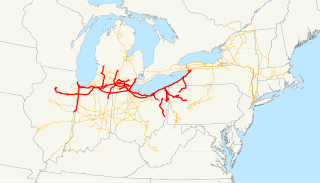
The Lake Shore and Michigan Southern Railway, established in 1833 and sometimes referred to as the Lake Shore, was a major part of the New York Central Railroad's Water Level Route from Buffalo, New York, to Chicago, Illinois, primarily along the south shore of Lake Erie and across northern Indiana. The line's trackage is still used as a major rail transportation corridor and hosts Amtrak passenger trains, with the ownership in 1998 split at Cleveland between CSX to the east, and Norfolk Southern in the west.
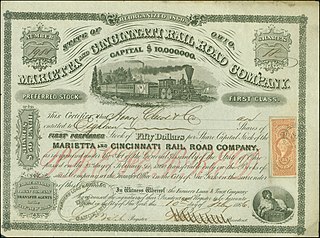
The Marietta and Cincinnati (M&C) was one of five important east-west railroads of southern Ohio; it was later absorbed by the Baltimore and Ohio Railroad (B&O). Its original route ran from Marietta through Vincent, Athens, Hamden, Chillicothe, Greenfield, Blanchester, and Loveland. It had two main branches: Blanchester to Hillsboro, which was originally part of the Hillsboro and Cincinnati Railroad; and Hamden to Portsmouth, Ohio, originally part of the Scioto and Hocking Valley Railroad.

The Western Maryland Railway was an American Class I railroad (1852–1983) which operated in Maryland, West Virginia, and Pennsylvania. It was primarily a coal hauling and freight railroad, with a small passenger train operation.

Buckingham Branch Railroad is a Class III short-line railroad operating over 275 miles (443 km) of historic and strategic trackage in Central Virginia. Sharing overhead traffic with CSX and Amtrak, the company's headquarters are in Dillwyn, Virginia in the former Chesapeake and Ohio Railroad (C&O) station, itself a historic landmark in the community. The railroad was featured in the January 2012 issue of Trains Magazine. It is referenced in the How It’s Made episode “Railway Bridge Ties”, showing it crossing a curved bridge.
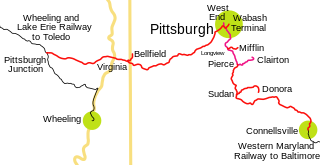
The Pittsburgh and West Virginia Railway was a railroad in the Pittsburgh, Pennsylvania and Wheeling, West Virginia, areas. Originally built as the Wabash Pittsburgh Terminal Railway, a Pittsburgh extension of George J. Gould's Wabash Railroad, the venture entered receivership in 1908 and the line was cut loose. An extension completed in 1931 connected it to the Western Maryland Railway at Connellsville, Pennsylvania, forming part of the Alphabet Route, a coalition of independent lines between the Northeastern United States and the Midwest. It was leased by the Norfolk and Western Railway in 1964 in conjunction with the N&W acquiring several other sections of the former Alphabet Route, but was leased to the new spinoff Wheeling and Lake Erie Railway in 1990, just months before the N&W was merged into the Norfolk Southern Railway.

The Hocking Canal was a small 19th century canal in southern Ohio that once linked Athens to Lancaster and the Ohio and Erie Canal, but was destroyed by flooding and never rebuilt. It paralleled the Hocking River.

The Cincinnati Northern Railroad was a railroad that stretched from Franklin, Ohio north to Jackson, Michigan, a distance of about 186 miles (299 km). It was acquired by the Cleveland, Cincinnati, Chicago and St. Louis Railway in 1901 and the New York Central Railroad several years later. Most of the line has since been abandoned.

Columbus and Ohio River Railroad is a railroad in the U.S. state of Ohio owned by Genesee & Wyoming Inc.

State Route 216 is a north–south state highway in the southeastern quadrant of the U.S. state of Ohio. The southern terminus of SR 216 is at a three-way stop T-intersection with SR 78 in Murray City. SR 216's northern terminus is also at a three-way stop T-intersection, this time with SR 93 in New Straitsville.
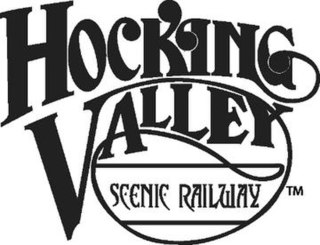
The Hocking Valley Scenic Railway is a non-profit, 501c3, volunteer-operated tourist railroad attraction that operates out of Nelsonville, Athens County, Ohio. It is also located near the popular Hocking Hills State Park in nearby Hocking County. It uses former trackage of the Chesapeake & Ohio Railway, which was in turn originally Hocking Valley Railway trackage. The current operation was founded in 1972.

The Columbus Subdivision is a freight railroad line extending from Columbus, Ohio, north to Fostoria, Ohio. The line is currently owned by CSX Transportation.

The Ohio Southern Railroad operated between Ironton, Ohio, and Lima, Ohio, from 1893 and 1905. Beginning in 1878 as the narrow gauge Springfield, Jackson and Pomeroy Railroad, it ran from Jackson-Wellston, Jackson County to Springfield, Ohio. The line was converted to a standard gauge by 1880 and renamed the Ohio Southern Railroad in 1881. From Jeffersonville, branch lines were started towards Columbus to the northeast and Cincinnati to the southwest, but never completed. By September 1893, the Ohio Southern had reached north to Lima with a bridge over the Great Miami River at Quincy. At Lima, the freight could link to the Lima Northern Railway for points further north. In 1898, the Lima Northern became the Detroit and Lima Northern Railroad (D&LN). Ohio Southern depots continue to stand in St. Johns, Uniopolis, Jackson Center, Quincy, and Rosewood.
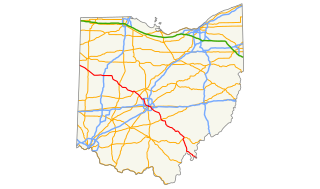
U.S. Route 33 (US 33) is a United States Numbered Highway running from near Elkhart, Indiana, to Richmond, Virginia. Within the state of Ohio, it is a predominantly southeast–northwest highway running from west of Willshire before crossing over into West Virginia via the Ravenswood Bridge over the Ohio River. The route runs through largely rural territory throughout most of the state's west-central, central, and southeastern regions, although it also passes through large portions of downtown Columbus.
Lake Superior and Ishpeming Railroad No. 33 is a preserved SC-1 class 2-8-0 "consolidation" type steam locomotive originally built by the Baldwin Locomotive Works in April 1916 for the Munising, Marquette and Southeastern Railway as No. 44. In 1924, the MM&SE was purchased by the Lake Superior and Ishpeming Railroad and the locomotive was renumbered to 33. It served the LS&I by pulling heavy iron ore trains until it was retired from revenue service in 1962. The following year, it was sold to the Marquette and Huron Mountain tourist railroad to operate in excursion service, but instead sat idle in Marquette. In 1965, No. 33 was purchased by the founders of the Hocking Valley Scenic Railway in Ohio. Rebuilt to operating condition, No. 33 ran on the HVSR for many years before being sidelined in 1996 for an FRA-required overhaul that couldn't be accomplished. In 2003, No. 33 was traded to the Ohio Central Railroad and was overhauled for some occasional excursion runs between 2005 and 2008. The locomotive briefly operated again around the Age of Steam Roundhouse between 2018 and 2020. As of 2021, No. 33 is sidelined, awaiting for extensive firebox repairs.

















